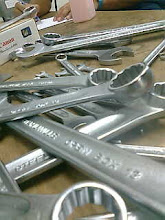Slowly, companies were dying out or being bought. The amalgamation of companies like BSA-Norton-Villiers-Triumph might have made financial sense, but the consolidation of manufacturing and engineering into a small number of firms only made the industry stagnate. Too few designers and too little competition was the death knell for the industry. What had been friendly competition by independent firms became bitter internal rivalry after amalgamation. Racing was also losing its support as sponsors pulled out in favour of automobile racing. The public lost its previous passion for the marques.
The final blow to the British motorcycle industry came with the increasing import of Japanese motorcycles into the USA and European markets. Less expensive than domestic machines, they were more reliable, and showed more innovation and engineering development than their British counterparts. British companies were too slow to react to the competition: their roots were essentially Victorian in both management and production. Too many manufacturers were making bikes for a small group of enthusiasts or for racing, rather than as public transport. There was no real up-scale market for these motorcycles at the time, but most manufacturers continued to produce expensive machines - until their small market dried up and they closed. Many never appreciated the market for commuter bikes.
The Japanese rebuilt the image of motorcycling as the pastime of everyone, not just a clique of enthusiasts. Motorcycles were fun, friendly and ridden by the nicest people, as Honda's ads reported. They invigorated the market and pushed up sales, especially targetting the teen and young adult consumers. But the British industry was doomed. It couldn’t even ride the coattails of the Japanese successes because it couldn’t change quickly enough. Their products couldn’t compare, they couldn’t make enough, and the Japanese were winning the races that had been the pride of the British for so long. The CB 750, introduced by Honda in 1968, took the industry by surprise: it was bigger, faster and better than anything the British could offer. No one had really believed he Japanese could make motorcycles of this size, but they did and it blew the competition away.
British manufacturers had always been hesitant to reinvest in more modern machinery, so production was often based on pre-WW2 equipment; slow, outdated and expensive to maintain - often using hand tooling instead of production line processes. Company owners and directors continued to take dividends out of the firms, at a time when the Japanese were borrowing heavily to invest in the most modern production equipment. The Japanese put their earnings back into the companies. The result was that British motorcycle quality was visibly deteriorating; styling was antiquated. Meanwhile the Japanese motorcycles were reliable, inexpensive and visibly modern.
Production was often limited, and sometimes focused on more lucrative export sales rather than domestic. BSA made 100,000 lightweight Bantams from 1948-53, but that was a small fraction of the one million small 50cc Quickly mopeds made by NSU from 1953 to 59. Plus, the Bantam had none of the styling of the Italian or German vehicles that attracted consumers. Since 1958, Honda has produced more than 26 million Super Cubs, proving that there is a market for small, lightweight two-wheelers.
BSA was one of the few firms to upgrade equipment and install new machinery after WW2 - including a semi-automated computerized assembly line considered to be the most advanced outside of Japan. But a series of market failures (including the pathetic Ariel Three moped, 90cc Dandy scooter and 75cc Beagle) lost the company considerable money in the 1960s, so BSA was forced to sell off their assets. The company was left with only enough to continue to make the Rocket Three, and soon closed its doors.
The role of the motorcycle shifted in the 1960s, from the tool of a life to a toy of a lifestyle. It became part of an image, of status, a cultural icon for individualism, a prop in Hollywood B-movies. It also became a recreational machine for sport and leisure, a vehicle for carefree youth, not essential transportation for the mature family man or woman. As the motorcycle riders of the Sixties aged, took on families, careers and homes, they purchased cars and put away the motorcycle, or simply sold it. Sales began to fall after the brief euphoria of the 1960s and the Hippie movement dimmed.
Subscribe to:
Post Comments (Atom)






0 comments:
Post a Comment